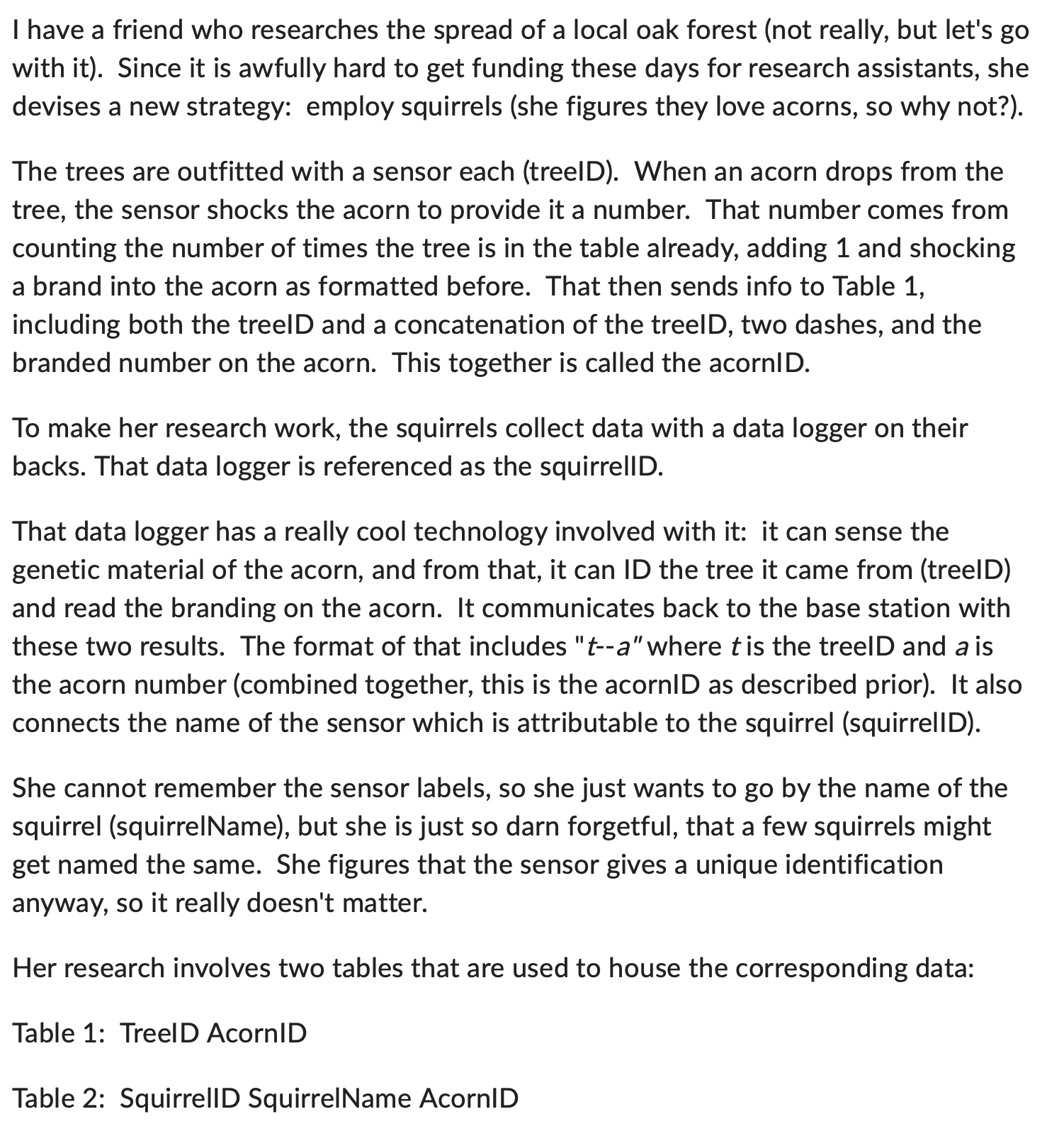Answered step by step
Verified Expert Solution
Question
1 Approved Answer
I have a friend who researches the spread of a local oak forest (not really, but let's go with it). Since it is awfully




I have a friend who researches the spread of a local oak forest (not really, but let's go with it). Since it is awfully hard to get funding these days for research assistants, she devises a new strategy: employ squirrels (she figures they love acorns, so why not?). The trees are outfitted with a sensor each (treelD). When an acorn drops from the tree, the sensor shocks the acorn to provide it a number. That number comes from counting the number of times the tree is in the table already, adding 1 and shocking a brand into the acorn as formatted before. That then sends info to Table 1, including both the treeID and a concatenation of the treelD, two dashes, and the branded number on the acorn. This together is called the acornID. To make her research work, the squirrels collect data with a data logger on their backs. That data logger is referenced as the squirrellD. That data logger has a really cool technology involved with it: it can sense the genetic material of the acorn, and from that, it can ID the tree it came from (treelD) and read the branding on the acorn. It communicates back to the base station with these two results. The format of that includes "t--a" where t is the treelD and a is the acorn number (combined together, this is the acornID as described prior). It also connects the name of the sensor which is attributable to the squirrel (squirrelID). She cannot remember the sensor labels, so she just wants to go by the name of the squirrel (squirrelName), but she is just so darn forgetful, that a few squirrels might get named the same. She figures that the sensor gives a unique identification anyway, so it really doesn't matter. Her research involves two tables that are used to house the corresponding data: Table 1: Treel D AcornID Table 2: SquirrelID SquirrelName AcornID Of particular note: There's a particular phrase in our language called "squirreling away" that is suggested by how squirrels deal with acorns: if they collect an acorn, they will hoard it. They want as many as they can. Also, if you go outside in the fall and you look down at the ground, you will see a lot of acorns. There are way more of them than there are squirrels. Take note of the difference in the number of them that there are and also that you can see acorns on the ground. That is pivotal information here. Question 1 (1 point) Which of these best defines primary key? A constraint that connects two tables together Something that makes intuitive sense to search for, such as a student's name as opposed to their ID number Identifier of record for the dataset Question 2 (1 point) Which of these best defines secondary key? A constraint that connects two tables together Identifier of record for the dataset Something that makes intuitive sense to search for, such as a student's name as opposed to their ID number Question 3 (1 point) Which of these best defines foreign key? Something that makes intuitive sense to search for, such as a student's name as opposed to their ID number A constraint that connects two tables together Identifier of record for the dataset Question 4 (1 point) Which of these is the primary key of Table 1? AcornID TreelD and Acorn ID (Composite) Treel D Question 5 (1 point) Which of these is the primary key of Table 2? SquirrelID and AcornID (Composite) SquirrelName SquirrelName and AcornID (Composite) SquirrellD SquirrelName and SquirrelID (Composite) SquirrellD, SquirrelName, and AcornID (Composite) AcornID Question 7 (1 point) Which table is the one that would have the foreign key constraint within it (namely the one that needs to be constrained)? Table 1 Table 2 Question 8 (1 point) Which field is most likely to be used as a secondary key? SquirrelName AcornID SquirrelID Treel D Submit Quiz O of 8 questions saved
Step by Step Solution
★★★★★
3.48 Rating (148 Votes )
There are 3 Steps involved in it
Step: 1
This quiz involves concepts related to database keys primary secondary and foreign keys These are important terms in the context of relational databas...
Get Instant Access to Expert-Tailored Solutions
See step-by-step solutions with expert insights and AI powered tools for academic success
Step: 2

Step: 3

Ace Your Homework with AI
Get the answers you need in no time with our AI-driven, step-by-step assistance
Get Started


